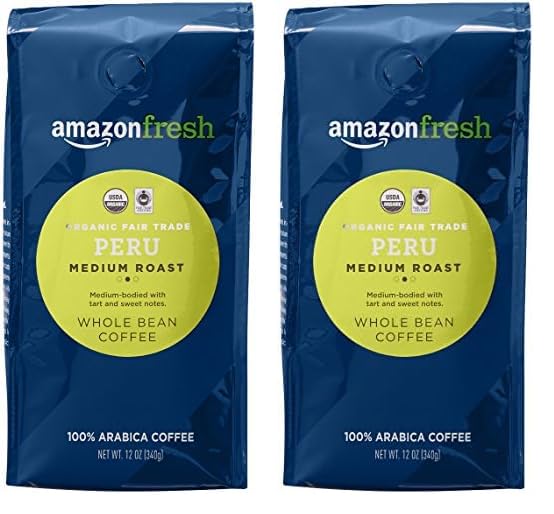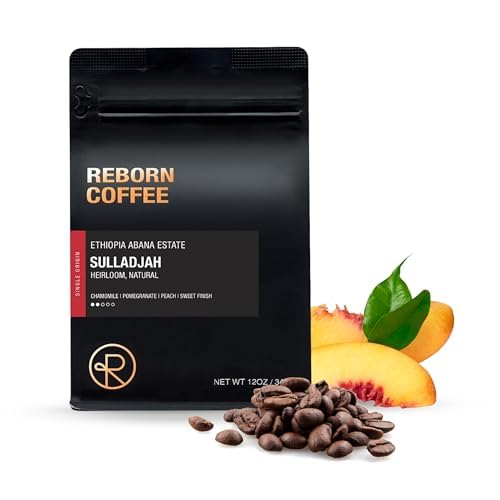
One Hundred Coffee is reader-supported, and some products displayed may earn us an affiliate commission. Details
For home roasters, creating a custom roast profile is both an art and a science. It allows you to fine-tune your coffee roasting process, unlocking complex flavors and aromas that align with your taste preferences. By experimenting with roasting times and temperatures, you can control acidity, sweetness, and body, ultimately shaping a unique and personalized coffee experience. This guide will walk you through key considerations, techniques, and strategies for developing your roast profile at home.
Who is this for?
This AmazonFresh Organic coffee is ideal for eco-conscious coffee lovers who enjoy smooth, balanced medium roasts. Certified organic and fair trade, it appeals to those who care about ethical sourcing and great taste. Perfect for daily brewing, it suits French press, drip, or pour-over enthusiasts alike.Understanding Roast Profiles
A roast profile refers to the combination of time, temperature, and airflow used during roasting. It dictates how heat is applied to the coffee beans and impacts their final taste. Several factors influence roast development, including:
- Bean Origin – Different beans respond to heat differently depending on their density, moisture content, and processing method.
- Roast Level – Light, medium, and dark roasts each require specific temperature ranges and roasting durations.
- Rate of Rise (RoR) – The speed at which the bean temperature increases affects how flavors develop.
- Development Time – The length of time beans spend between the first crack and the end of roasting determines balance and complexity.
Choosing the Right Beans for Experimentation
Selecting high-quality green coffee beans is the foundation of a great roast profile. Consider experimenting with different origins, processing methods, and altitudes to see how each reacts to heat. Here are some suggestions:
- Ethiopian Beans (Washed) – Bright acidity, floral and citrus notes; best suited for light to medium roasts.
Who is this for?
Reborn Coffee’s Ethiopian Sulladjah roast is crafted for those who appreciate refined, fruity coffee with complexity and clarity. These washed Ethiopian beans highlight pomegranate and citrus notes, offering a crisp, clean cup with a bright finish. Ideal for specialty coffee lovers, pour-over brewers, or anyone who values traceable, farm-to-cup experiences. Whether you’re a home barista chasing fruit-forward flavors or a casual drinker looking to upgrade your morning routine, this roast delivers a balanced, aromatic profile. Its light-medium body and high acidity make it a standout for those who want elegance and flavor in every carefully roasted batch.What we loved
The distinct pomegranate flavor is a refreshing twist on traditional washed Ethiopian profiles. We loved the clean, high-acidity finish, and how well it performs in pour-over and Chemex brews.Final verdict
A complex, fruit-forward Ethiopian coffee perfect for adventurous drinkers who appreciate high-quality, traceable beans with vibrant acidity and standout character.- Colombian Beans (Washed) – Balanced sweetness and body; versatile across all roast levels.
Who is this for?
Zulu Yellow Gesha Coffee is crafted for high-end coffee connoisseurs who crave rare, aromatic beans with exotic flavor complexity. Hand-harvested in Colombia and processed using traditional washed methods, this Gesha variety offers bright floral notes, citrusy sweetness, and tea-like body. It’s ideal for pour-over, Chemex, and filter lovers who appreciate nuanced profiles and a silky mouthfeel. Whether you’re brewing solo or impressing guests, this is a sensory experience for those who value single-origin purity, careful processing, and sustainable sourcing. If you’re exploring the best of specialty beans, this high-elevation Gesha is a perfect addition to your tasting journey.What we loved
We loved the smooth, floral-forward cup that evolves with every sip. Its crisp acidity, elegant sweetness, and incredibly clean finish show the craftsmanship behind every batch.Final verdict
A top-shelf micro-lot Gesha for coffee explorers who seek clarity, aroma, and balance in every cup. Elegant, rare, and worth savoring slowly.- Brazilian Beans (Natural) – Low acidity, chocolatey, and nutty flavors; great for medium to dark roasts.
Who is this for?
Equal Exchange Organic Coffee is ideal for ethically-minded coffee lovers who want bold flavor and social impact in one brew. Sourced directly from small farmers in Brazil, this naturally processed coffee boasts deep chocolate tones, low acidity, and a full-bodied profile. It’s perfect for French press, drip, or espresso drinkers who appreciate sustainable agriculture and traceable origins. Certified organic and fair trade, it’s a daily brew with purpose. Great for those seeking a smooth, reliable cup with no bitterness—just rich, earthy satisfaction in every sip. Drink it knowing each bag supports cooperative farming and environmental responsibility.What we loved
We loved its chocolatey depth and earthy balance—smooth, not bitter, and comforting to the last drop. Its consistent quality makes it a favorite for everyday brewing.Final verdict
A rich, ethical everyday coffee with chocolate warmth and full flavor. Great for conscientious coffee lovers who appreciate quality with a mission behind every cup.- Sumatran Beans (Wet-Hulled) – Earthy, bold, and full-bodied; works well with darker roasts.

Who is this for?
Starbucks Sumatra Whole Bean Coffee is ideal for those who prefer bold, earthy flavors with low acidity and full-bodied richness. This dark roast is crafted using wet-hulled Sumatran beans, known for their herbal, spicy undertones and lingering finish. It’s perfect for French press, espresso, or drip brewers. Whether you’re a seasoned dark roast enthusiast or someone exploring complex coffee profiles, Sumatra delivers an intense, satisfying experience. Ethically sourced and roasted for maximum impact, it appeals to conscious consumers and strong-brew lovers alike. For anyone seeking a deep, grounded cup with character, this roast is a standout.What we loved
The herbal complexity and deep, earthy body make this coffee memorable. Its wet-hulled profile stands out, offering richness and depth that’s bold without bitterness. Great for slow sipping.Final verdict
If you love dark, spicy, and low-acid coffee, this Sumatran roast is a classic must-try—powerful, smooth, and unapologetically bold from first sip to last.Setting Up Your Roasting Experiment
To develop a custom roast profile, you need a controlled and repeatable process. Follow these steps:
1. Record Baseline Data
Before experimenting, establish a baseline roast using a standard time and temperature setting. Track the following:
- Starting temperature
- Roasting duration
- First and second crack times
- Final roast temperature
- Cupping notes on aroma, acidity, and body
2. Adjust Roasting Variables
To create a unique roast profile, experiment with different variables:
- Temperature Ramping: Increase or decrease heat application at various stages.
- Roasting Time: Extend or shorten the roasting process to highlight different flavors.
- Development Time: Adjust how long the beans remain between the first and second crack.
- Cooling Process: Test how rapid vs. slow cooling affects the final taste.
3. Compare & Evaluate Results
After each roast, cup your coffee to analyze the flavor changes. Take detailed notes, and compare:
- Acidity – Bright and citrusy vs. mellow and smooth.
- Sweetness – Caramelized vs. underdeveloped sugars.
- Body – Light and tea-like vs. heavy and syrupy.
- Bitterness – Balanced vs. overpowering.
Experimenting with Roasting Times
Short vs. Long Roasting Times
- Shorter Roast Times (8-10 minutes) – Preserve acidity and floral notes, but may risk underdevelopment.
- Longer Roast Times (12-15 minutes) – Enhance body and sweetness, but can mute bright flavors if overdone.
Manipulating Development Time
The period between the first crack and the end of the roast is crucial for flavor balance:
- Short Development Time (1-2 minutes): Higher acidity, crisp flavors.
- Extended Development Time (2.5-4 minutes): Richer body, caramelized sweetness.
Experimenting with Roasting Temperatures
Adjusting Temperature Stages
Roasting temperatures impact how beans develop over time. Consider:
- Lower Starting Temperatures (300-350°F) – More gradual heat application, enhancing clarity.
- Higher Starting Temperatures (375-400°F) – Faster heat transfer, boosting caramelization.
- Final Roast Temperatures:
- Light Roast: 385-400°F (First Crack Stage)
- Medium Roast: 405-425°F (Post First Crack)
- Dark Roast: 430-450°F (Approaching Second Crack)
Testing Different Heat Ramps
- Fast Heat Ramping: Produces bright, acidic notes with higher clarity.
- Slow Heat Ramping: Develops sweetness and body while reducing acidity.
Tracking Your Results
Creating a Roast Log
Keep a detailed roasting journal to track your experiments:
| Roast Date | Bean Origin | Time | Temperature | First Crack | Second Crack | Cupping Notes |
|---|---|---|---|---|---|---|
| MM/DD/YYYY | Ethiopia Yirgacheffe | 10 min | 400°F | 6:30 min | N/A | Bright acidity, floral, light body |
| MM/DD/YYYY | Brazil Santos | 12 min | 430°F | 8:00 min | 10:30 min | Nutty, chocolate, smooth |
Using a roast log helps identify patterns and refine techniques over time.
Final Thoughts
Developing your custom roast profile takes practice, patience, and experimentation. By adjusting time and temperature variables, you can craft a roast that highlights your favorite coffee characteristics. Whether you prefer a bright, fruity light roast or a deep, chocolatey dark roast, fine-tuning your roasting process allows for endless exploration and a truly personalized coffee experience. Start experimenting today and enjoy the journey of discovering your perfect roast!










